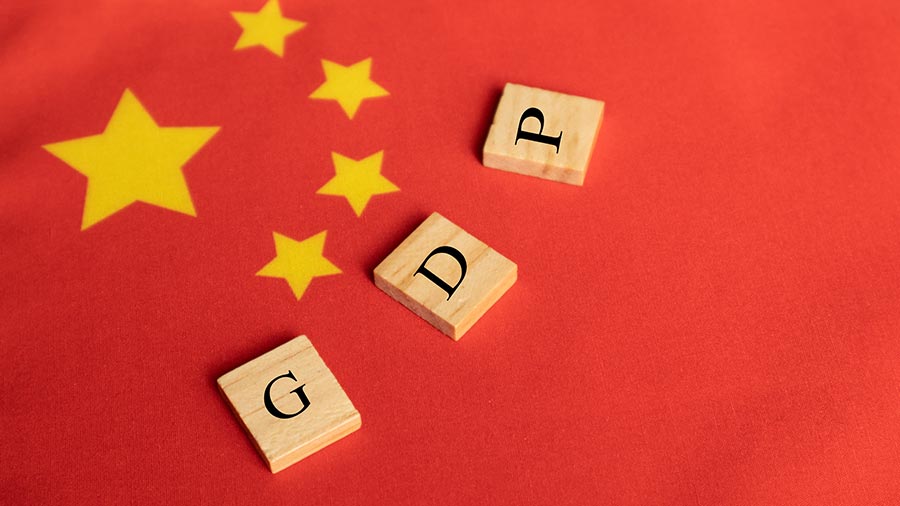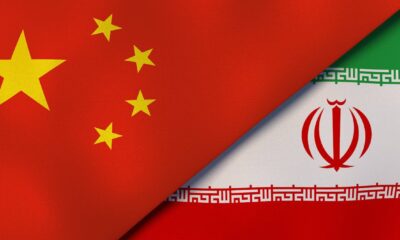China
China says AUKUS is ‘driven by Cold War thinking’. Here are 3 reasons it is so threatened by the pact

China opposes AUKUS, viewing it as a Cold War relic that threatens its nuclear strategy. The pact complicates China’s geopolitical landscape and could shift regional military balance, posing significant challenges.
Ever since AUKUS’ public announcement three years ago, China has been staunchly opposed to the partnership.
Beijing has blasted AUKUS diplomatically and mounted a concerted campaign to challenge its legality.
China has said AUKUS is “driven by Cold War thinking,” “fuelling military confrontation,” and creating “additional nuclear proliferation risks”.
The aim of AUKUS is for the Australian navy to acquire nuclear-powered submarines, with Australia, the United Kingdom and the United States also collaborating on other advanced military technologies.
As AUKUS sceptics have argued, it’s entirely possible Australia will never get its planned nuclear-powered attack submarines. Any number of factors — from the mercurial whims of a future US president to American shipbuilding constraints — could see the partnership fall over.
However, if the plan succeeds, even in a modified form, it’ll pose a serious military challenge to China. As Kevin Rudd, the former Australian prime minister and current ambassador to the US, said in recent days, it’s probably already complicating China’s future geopolitical calculations.
When Chinese military analysts look at the geopolitical picture, they see it more clouded and cluttered than they did before.
Here are three reasons why China finds the pact so threatening.
1. Complicating China’s nuclear strategy
AUKUS submarines will not be armed with nuclear warheads. But these boats could be used to endanger China’s sea-based nuclear weapons.
China currently operates six submarines that are both nuclear-powered and capable of launching nuclear weapons. These are based on Hainan Island, where they enjoy the protection of hardened bases. They can quickly reach the deep waters of the South China Sea to reduce the likelihood of detection.
Monitoring China’s nuclear weapons-capable submarines as they leave Hainan Island is likely to be among the most important of the many missions for the AUKUS boats.
The increased speed, stealth and endurance of AUKUS submarines mean they’d be able to reach the South China Sea quicker. Once there, they can stay “on station” undetected for much longer.
This peacetime monitoring of China’s nuclear weapons-capable submarines would help build a better understanding of their hydro-acoustic signatures and thereby make these Chinese boats more vulnerable to detection.
Combined with the intelligence gathered by Australia’s regular South China Sea maritime air patrols, AUKUS submarines could eventually enhance the ability of the Australian and allied militaries to track and, in conflict scenarios, attack China’s sea-borne nuclear deterrent.
A Chinese nuclear submarine participates in a naval parade to commemorate the 70th anniversary of the founding of China’s PLA Navy in 2019.
Mark Schiefelbein/AP Pool
2. A direct military threat to China
Foreign Minister Penny Wong has said in connection to AUKUS that Australia needs to be able to “hold potential adversaries’ forces and infrastructure at risk from a greater distance”.
She might not have mentioned China in the same breath. But like many Australians, military planners in Beijing would imagine China is the most probable target.
Likely armed with Tomahawk cruise missiles capable of striking land, AUKUS submarines could be used to target Chinese military bases and infrastructure in the South China Sea and along the country’s east coast.
A frame grab from a video provided by the Philippine Coast Guard shows structures on the Chinese-occupied Subi reef in the disputed waters of the South China Sea.
Philippine Coast Guard/AP
AUKUS submarines could also constrict China’s access to the economic inputs essential for warfighting. China remains acutely dependent on Indian Ocean and East Asian shipping lanes for imports of oil and other resources. The ability of AUKUS submarines to travel vast distances without surfacing or refuelling could allow them to threaten China’s vital maritime supply routes in conflict scenarios.
Beijing might even imagine that AUKUS submarines could be used to directly attack Chinese cities in an all-out war. This might seem far-fetched for now, but with military planning often dealing with worst-case scenarios, Chinese defence strategists are probably considering this possibility.
3. Further tipping the regional military balance
Australia is expected to buy at least three – and possibly as many as five – Virginia-class submarines from the United States in the next decade and a half.
These boats might have otherwise gone into the US fleet, meaning that until 2040 and perhaps even beyond, the size of the American nuclear-powered submarine force could be smaller than it would have been without AUKUS. And there is still much uncertainty surrounding the political and industrial feasibility of both the planned sale of Virginia-class submarines and the construction of a new AUKUS class of boat.
But assuming it’s successful, AUKUS will substantially increase the total number of nuclear-powered submarines operated by the US and its allies from around the 2040s onwards, potentially giving them a long-term undersea military advantage over China.
In the near term, AUKUS could also enable the deployment of additional high-end US and allied military platforms to the region.
Of course, this isn’t just an AUKUS story. Australia will welcome more US bombers and fighter aircraft in the coming years, and we’ll likely see larger US forces in Japan and the Philippines, among other locations.
Still, the establishment of Submarine Rotational Force – West under the AUKUS plan will see a big boost to US and allied military power in the region. It’s expected to involve the rotational presence of one UK and up to four US nuclear-powered submarines in Western Australia from 2027.
This might mean a weakening of China’s relative submarine strength in the region regardless of what happens with the eventual delivery and construction of nuclear-powered submarines for Australia.
This is not a complete account of all the reasons China might have for opposing AUKUS. But these three factors alone suggest the partnership has the potential to pose a significant and long-term military challenge to Beijing.
This article is republished from The Conversation under a Creative Commons license. Read the original article.
Business
China Reports Agreement on Ceasefire between Myanmar’s Factions

Myanmar’s conflicting parties have reached a ceasefire agreement, facilitated by China, aiming to reduce violence and promote peace in the region.
Myanmar Ceasefire Agreement
In a significant development, conflicting parties in Myanmar have reached an agreement for a ceasefire, with China facilitating discussions. This breakthrough is crucial for restoring peace in a nation that has been marred by violence and political strife in recent years. The ceasefire aims to pave the way for reconciliation efforts and improve the humanitarian situation in affected areas.
Role of China
China’s involvement as a mediator highlights its growing influence in resolving regional conflicts. The Chinese government has been working closely with both sides to promote dialogue and trust, crucial elements for a long-term peace solution. Increased stability in Myanmar can benefit regional security and economic development, making China’s mediation significant.
Looking Forward
The hope is that this ceasefire will lead to further negotiations addressing underlying issues in Myanmar. While challenges remain, both parties have expressed willingness to work towards a peaceful resolution. The international community will be watching closely to see if this ceasefire can be sustained and lead to enduring peace for the people of Myanmar.
China
2024 China Economic Review: GDP, Trade, and Foreign Direct Investment Analysis

In 2024, China’s economy grew 5%, supported by stimulus measures, strong exports, and high-tech investments, despite weak domestic demand and demographic challenges. Key sectors like manufacturing and digital economy thrived, necessitating structural reforms for sustained growth into 2025.
China’s economy grew 5% in 2024, driven by stimulus measures, strong exports, and high-tech investment, despite challenges like weak domestic demand and demographic pressures. Structural reforms and targeted policies are essential for sustaining growth into 2025.
China’s economic performance in 2024 saw a return to steady growth, achieving a 5 percent GDP expansion in line with the government’s target, as per the official data released by the National Bureau of Statistics (NBS) on January 17, 2025. This outcome was largely bolstered by stimulus measures that helped drive a stronger-than-expected fourth-quarter recovery. While the country’s economy faced challenges such as declining population numbers and sluggish consumer demand, there were signs of optimism across key sectors, including industrial output and digital economy growth.
Additionally, China is beginning to pivot away from its dependence on the property sector, with the digital economy playing an increasingly significant role in economic expansion.
This article explores the major economic highlights from 2024 and examines the key trends, challenges, and opportunities that will shape China’s economy in the year ahead.
In 2024, China’s GDP reached RMB 134.91 trillion (US$18.80 trillion), maintaining its position as the second-largest economy in the world, behind only the United States, whose projected GDP for 2024 stands at approximately US$29 trillion. This reflects a year-on-year growth of 5.0 percent, in line with the government’s official target of “around 5 percent“ set during the 2024 Two Sessions. While slower than the 5.2 percent growth achieved in 2023, it highlights a stable recovery largely driven by strong export performance and targeted stimulus measures throughout the year.
The economy saw accelerated growth in the final quarter of 2024, with GDP expanding by 5.4 percent, surpassing expectations and making a substantial contribution to the overall 5.0 percent increase. Indeed, quarterly growth performance in 2024 showed steady improvement: the first quarter recorded a 5.3 percent increase, followed by 4.7 percent in Q2, and 4.6 percent in Q3.
Sectoral performance highlights revealed the manufacturing and service sectors as key drivers.
| This article was first published by China Briefing , which is produced by Dezan Shira & Associates. The firm assists foreign investors throughout Asia from offices across the world, including in in China, Hong Kong, Vietnam, Singapore, and India . Readers may write to info@dezshira.com for more support. |
Read the rest of the original article.
China
How China’s appetite for salmon could reshape global seafood markets – new research

China’s salmon demand surged 46% in 2023, prompting global exporters to respond. Challenges in domestic salmon production highlight opportunities for rainbow trout, reshaping the seafood market towards sustainability and consumer preferences.
China’s demand for farmed salmon is growing at an unprecedented pace. In 2023, its imports grew by 46% year on year – with imports of fresh and chilled Atlantic salmon up 63%.
This remarkable growth is reshaping the global seafood trade. Exporters from Scotland, Norway, Chile, Australia, Faroe Islands, Canada and Iceland are racing to supply the needs of this vast and rapidly evolving market.
At the same time, China’s efforts to produce its own Atlantic salmon have faced significant challenges, highlighting the need for substitutes like rainbow trout to meet the country’s growing appetite for seafood delicacies.
An important shift occurred in 2018, when the Chinese government permitted rainbow trout to be labelled and sold as salmon. This decision blurred the distinction between imported Atlantic salmon and locally farmed rainbow trout, creating a more accessible option for cost-sensitive consumers.
Trout is comparable to salmon in appearance and size, with firm and oily meat that has a similar orange-pink colour. Nutritionally too, the species are alike, as are the ways in which they can be cooked and prepared.
In our new research which included taste tests, we found that many Chinese consumers could not distinguish between domestic rainbow trout and imported Atlantic salmon in blind testing. But when informed about the origin, testers’ preferences shifted strongly in favour of imported Atlantic salmon, highlighting the power of provenance in consumer tastes.
Although people’s willingness to pay did not vary initially in our blind tests, it became a decisive factor once the origin of the fish was revealed.
But we found that origin alone was not enough. For our testers to be prepared to pay higher prices, they also had to like the look, smell and taste of the product more, or be persuaded by its ecolabel (indicating environmental standards).
Environmental costs
Transporting Atlantic salmon from Scottish lochs, Norwegian fjords or Chilean waters to Chinese markets involves complex logistics and significant environmental costs. The carbon footprint of this trade, combined with the resource-intensive nature of salmon aquaculture, raises critical concerns about sustainability.
These challenges are particularly pronounced in China, where consumers have a strong preference for freshness. This drives demand for quick delivery of imported salmon despite its environmental impact, and consumers are increasingly turning to online platforms to buy their seafood.
E-commerce has reshaped seafood retail in China, offering quick delivery and products that cater to consumer demand for quality and freshness. Salmon stands out in this market due to its perceived high value, premium quality and price point. Unlike other expensive seafood that often needs to be sold live to maintain its value, salmon retains its appeal when chilled or frozen.
This makes salmon particularly suited to modern retail models, where sophisticated cold-chain logistics ensure its freshness without the complexities of live transport. However, these innovations come at a cost.
The energy-intensive storage and rapid transportation required for imported salmon contribute significantly to environmental harm. As China’s seafood market continues to grow, addressing the sustainability challenges associated with this trade will be critical to balancing consumer demand with environmental responsibility. Current international certification schemes aiming to improve the sector’s sustainability have had limited impact in China so far.
A worker processing imported fresh salmon in a Beijing wholesale seafood market.
David Little, Author provided
China has made significant efforts to establish a domestic Atlantic salmon industry, but these attempts have largely been unsuccessful due to technical challenges and environmental constraints. This has left a gap that domestically farmed rainbow trout is poised to fill.
A trout farming raceway in Chengdu, China, supplied with fresh river water.
Zixuan Ma, Author provided
In 2022, China produced 37,000 tonnes of rainbow trout. This is a relatively small amount compared with international production levels, but still notable considering that rainbow trout is a new farmed species in China, unlike traditional species like carp.
However, rainbow trout farming in China is geographically constrained, as the species thrives in cooler freshwater temperatures found in higher-lying lakes and reservoirs, as well as in “raceways” (channels supplied continuously with fresh water diverted from rivers).
Advances in aquaculture systems offer a potential pathway to expand China’s production. Trout farming is a more sustainable, locally sourced alternative to Atlantic salmon that reduces the carbon footprint associated with imports and ensures fresher options for Chinese consumers. Developing a robust domestic trout industry could enhance food security, reduce dependence on imports, and create economic opportunities in rural areas.
China’s evolving seafood market offers valuable lessons for the global industry. Emphasising quality, freshness and sustainability will resonate with the increasingly sophisticated Chinese consumer.
At the same time, investment in eco-friendly aquaculture practices, both domestically and internationally, will be essential to balance the growing demand for premium seafood with environmental responsibility. These could include reducing feed waste and recirculating aquaculture systems (which filter and reuse water) to minimise water use. Recycling waste nutrients by using them elsewhere in food production could also be key.
As rainbow trout gains prominence in China’s seafood landscape, the relationship between consumer preferences, environmental concerns and economic opportunities could in turn shape the future of the global salmon trade.
If domestic fish captures a larger share of the Chinese market, salmon producers in Europe, Canada and other exporting regions may face significant challenges. This could ultimately force them to rethink their strategies in order to adapt to shifting market dynamics.
Although the goal of creating a domestic Atlantic salmon industry has proved difficult for China, trout farming presents a practical and sustainable solution for its luxury seafood sector.
This article is republished from The Conversation under a Creative Commons license. Read the original article.











